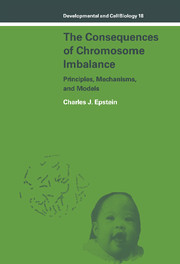Book contents
- Frontmatter
- Contents
- Preface
- Glossary
- PART I INTRODUCTION
- PART II CLINICAL OBSERVATIONS
- PART III THE THEORETICAL MECHANISMS AND ISSUES: THE PRIMARY AND SECONDARY EFFECTS OF ANEUPLOIDY
- PART IV EXPERIMENTAL SYSTEMS FOR THE STUDY OF MAMMALIAN AND HUMAN ANEUPLOIDY
- 10 Generation and properties of mouse aneuploids
- 11 Models for human aneuploidy
- PART V THREE MAJOR CLINICAL PROBLEMS OF HUMAN ANEUPLOIDY
- PART VI CONCLUSION
- Appendix: Standard karyotypes of man and mouse and human cytogenetic nomenclature
- References
- Index
11 - Models for human aneuploidy
Published online by Cambridge University Press: 14 October 2009
- Frontmatter
- Contents
- Preface
- Glossary
- PART I INTRODUCTION
- PART II CLINICAL OBSERVATIONS
- PART III THE THEORETICAL MECHANISMS AND ISSUES: THE PRIMARY AND SECONDARY EFFECTS OF ANEUPLOIDY
- PART IV EXPERIMENTAL SYSTEMS FOR THE STUDY OF MAMMALIAN AND HUMAN ANEUPLOIDY
- 10 Generation and properties of mouse aneuploids
- 11 Models for human aneuploidy
- PART V THREE MAJOR CLINICAL PROBLEMS OF HUMAN ANEUPLOIDY
- PART VI CONCLUSION
- Appendix: Standard karyotypes of man and mouse and human cytogenetic nomenclature
- References
- Index
Summary
In the previous chapter, I discussed mouse aneuploidy as a system in its own right, one capable of being used for a variety of studies of the effects of aneuploidy in mammals. At this point, it is worth considering explicitly the advantages of using such a system, many of which will have already become obvious. The major theoretical advantages to using animal models in general and the mouse in particular as experimental systems for studying the pathogenesis of aneuploid states have been discussed in earlier articles on the subject (Epstein, 1981a, 1985a; Epstein et al., 1984). Among the benefits expected to be derived from using animal models are the following:
Animals models facilitate the developmental analysis of the pathogenesis of abnormalities, particularly during crucial stages of organogenesis. Even if appropriate tissues were available in man, it would be impossible to carry out any investigations other than static biochemical or morphological examinations. In the mouse, studies of neurological and cardiac abnormalities have been of particular interest.
The in vitro and in vivo investigation of cells and tissues other than blood elements and fibroblasts becomes possible. This applies particularly to the central nervous system, the system most sensitive to the effects of aneuploidy in man but the most difficult to get at.
Aneuploid animals allow for the study of the preimplantation and early postimplantation stages of development which are particularly critical for an understanding of the effects of monosomy, as well as of trisomies and polyploidies which lead to early death in utero
[…]
- Type
- Chapter
- Information
- The Consequences of Chromosome ImbalancePrinciples, Mechanisms, and Models, pp. 235 - 250Publisher: Cambridge University PressPrint publication year: 1986



